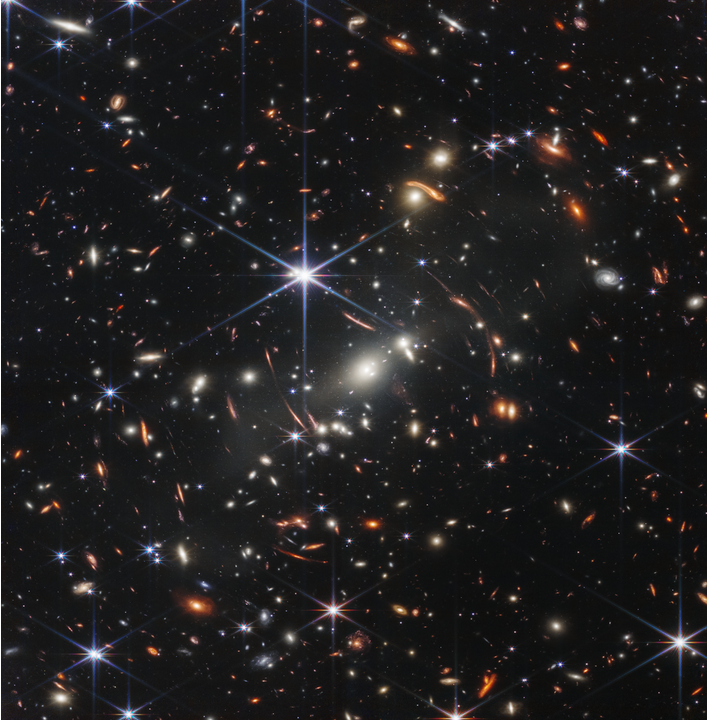This image, recorded in great detail by NASA’s James Webb Space Telescope, is being stirred up by a flurry of dazzling white galaxies. The collection of galaxies, called cluster SMACS 0723, also extends and duplicates the appearances of more distant galaxies in front of them by bending and twisting their light.
 Webb’s First Deep Field (NIRCam Image). Image Credit: RELEASE: NASA, ESA, CSA, STScI
Webb’s First Deep Field (NIRCam Image). Image Credit: RELEASE: NASA, ESA, CSA, STScI
Future researchers will be able to exquisitely catalog the exact compositions of galaxies in the early universe, thanks to Webb’s near- and mid-infrared imaging and incredibly detailed data known as spectra. This work may eventually reshape the understanding of how galaxies transformed and developed over billions of years.
The James Webb Space Telescope of NASA has produced the most detailed and precise infrared image of the outer reaches of the cosmos to date. Galaxy cluster SMACS 0723, also known as Webb’s First Deep Field, is home to thousands of galaxies, including some of the tiniest and weakest objects yet seen.
A small sliver of the immense universe, Webb’s image is about the size of a grain of sand held out at arm’s length. This galaxy cluster’s total mass functions as a gravitational lens to enlarge distant galaxies, especially, some that were first observed when the universe was only a few billion years old.
Webb’s Near-Infrared Camera (NIRCam), which combined images collected at various wavelengths over 12.5 hours, captured this deep field. This allowed for infrared depths greater than those reached by the Hubble Space Telescope’s deepest fields, which took weeks to capture. In addition, this is just the start. Researchers using Webb in the future, showing more of the enormous universe will take longer exposures.
In this view, the galaxy cluster SMACS 0723 is seen with a large number of additional galaxies in front of and behind it as it would have been 4.6 billion years ago. Scientists will learn a lot more about this cluster when they delve further into Webb’s data. Webb’s Mid-Infrared Instrument (MIRI), which monitors mid-infrared light, also captured a photograph of this field.
With the help of Webb’s NIRCam, distant galaxies have come into clear focus. These galaxies contain tiny, weak structures, such as star clusters and hazy patterns that have never been observed previously.
It took billions of years for the light from these galaxies to approach the earth. When observing the newest galaxies in this field, humans travel back in time to just a billion years after the big bang. The universe’s expansion caused the light to be bent, reaching the infrared wavelengths that Webb was made to study. The masses, ages, histories, and compositions of the galaxies will soon be the subject of increased research.
The prominent arcs in this field are another highlight. Similar to how a magnifying glass warps and bends images, a galaxy clusters a strong gravitational field. As stars look brighter at shorter wavelengths, they are also recorded with noticeable diffraction spikes.
The location of the dust, a key component of star formation and eventually life itself, is shown by Webb’s MIRI image, through a kaleidoscope of hues and highlights. Stars are present in blue galaxies, but there is minimal dust. This field’s red objects are obscured by many feet of dust.
There are hydrocarbons and other chemical substances in green galaxies. These kinds of data will help researchers better understand how galaxies develop, expand, merge, and, in some cases, why they stop producing stars altogether.
Two of Webb’s equipment, in addition, to taking photographs, also collected spectra, which are measurements of an object’s physical and chemical characteristics. This will aid researchers in this field in learning more specifics about distant galaxies.
A brand-new technique employed for the first time in space, Webb’s Near Infrared Spectrograph (NIRSpec) micro shutter array, observed 48 distinct galaxies simultaneously and returned a comprehensive set of information on each.
The information showed that one galaxy’s light traveled for 13.1 billion years before being caught by Webb’s mirrors. NIRSpec data also show the level of detail that galaxy spectra will have with Webb observations.
Finally, Wide-Field Slitless Spectroscopy was employed by Webb’s Near-Infrared Imager and Slitless Spectrograph (NIRISS) to simultaneously capture the spectra of every object in the complete field of vision. The findings demonstrate, among other things, that one of the galaxies has a mirror image.
In the southern sky, SMACS 0723 can be seen close to the constellation Volans.
The best space scientific observatory in the world is the James Webb Space Telescope. In addition to looking beyond the solar system to distant planets orbiting other stars, Webb will delve into the enigmatic architecture and origins of the cosmos and our role within it.
Webb is a global initiative run by NASA in conjunction with the Canadian Space Agency and the European Space Agency (Canadian Space Agency).
NASA Headquarters, on behalf of the Science Mission Directorate, manages the mission. Webb is managed by NASA’s Goddard Space Flight Center in Greenbelt, Maryland, which also coordinates work on the mission by Northrop Grumman, the Space Telescope Science Institute, and other mission partners.
Along with Goddard, other NASA facilities such as the Johnson Space Center in Houston, the Jet Propulsion Laboratory (JPL) in Southern California, the Marshall Space Flight Center in Huntsville, Alabama, the Ames Research Center in California’s Silicon Valley, amongst others contributed to the project.
A team from the University of Arizona and Lockheed Martin’s Advanced Technology Center created NIRCam.
A consortium of publicly financed European Institutes (the MIRI European Consortium), in collaboration with JPL and the University of Arizona, created and constructed MIRI with funding from ESA and NASA.
A group of European firms led by Airbus Defence and Space (ADS) constructed NIRSpec for the European Space Agency, with the detector and micro-shutter subsystems coming from NASA’s Goddard Space Flight Center.
The CSA donated NIRISS. In cooperation with the National Research Council of Canada and the University of Montréal, Honeywell designed and constructed the instrument.